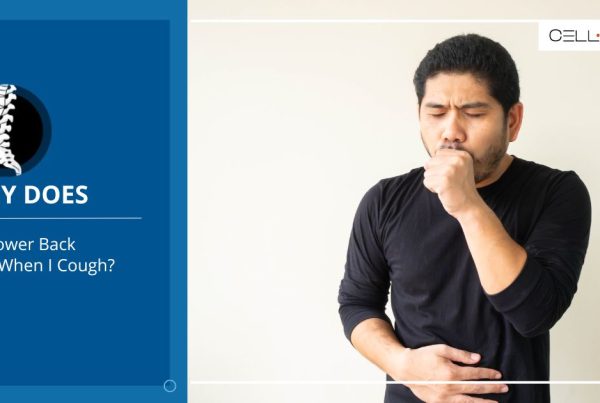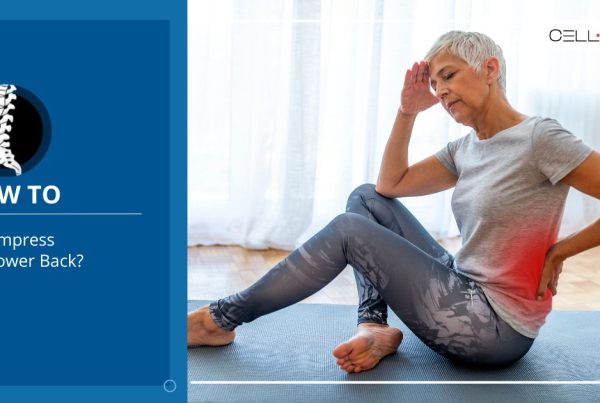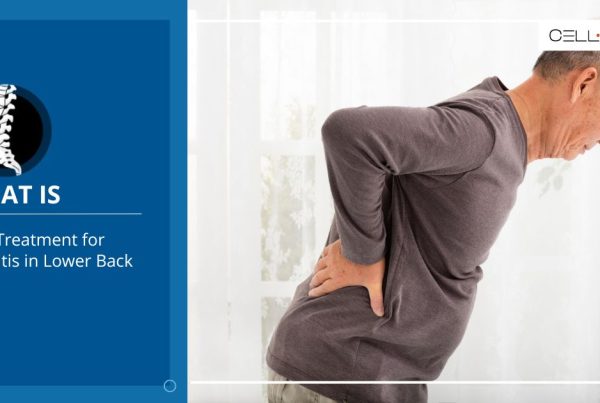Published on: October 22, 2024 | Updated on: January 18, 2025
Lower back pain, one of the most common medical problems, affects many people. What causes lower back pain in females? While menstruation, pregnancy, and hormonal problems are a leading cause, some other problems could also be held responsible.
According to research, the lifetime prevalence of lower back pain in females ranges from 50 to 80% — meaning that 80% of the females experience lower back pain at some point during their lives.
What Is Lower Back Pain?
Our lower back is the part of the body that starts at the bottom of our ribcage and extends to the tops of our legs.
Chronic back pain is widespread in adults and affects up to 23% of the population. These statistics make it essential to understand lower back pain, its causes, symptoms, and management.
Our spine consists of bony structures called vertebrae. The lower back has five lumbar vertebrae, the largest vertebrae of the human body.
This lumbar region of the spine supports our body weight through attached discs, vertebrae, muscles, ligaments, and tendons. A major trauma, injury, or strain to any of these vital structures can cause lower back pain.
Symptoms of Lower Back Pain in Females
Lower back pain can cause a combination of symptoms. Some common symptoms include the following.
- Dull, aching pain
- Constant radiating pain
- Sudden jolting pain
- Pain traveling down the back of the leg
- Sharp pain during movements
- Limited mobility
- Stiffness in the lower back
- Difficulty moving the body, such as bending or twisting
- Difficulty straightening the back
- Numbness
- Muscle spasms in the lower back
- Tingling sensation in the back
What Causes Lower Back Pain in Females?
Sitting in the same position with a bad posture for a long duration is one of the leading causes of back pain. Improperly lifting heavy objects can also strain your back muscles, causing backache.
Some other general causes are:
- Muscle strain
- Muscle spasm
- Ligament sprain
- Herniated disc
- Poor posture
- Sciatica
While lower back pain can affect any gender, specific underlying medical conditions related to menstruation or reproductive cycle can cause lower back pain in females. These include the following.
- Pregnancy
- Ovarian cysts
- Endometriosis
- Menstrual Cramps
- Osteoarthritis
- Rheumatoid Arthritis
Let’s understand more about these conditions and how they cause lower back pain in females.
Pregnancy
One of the most common musculoskeletal complaints during pregnancy is lower back pain, which affects about 50 to 70% of pregnant women.
The lower back manages the center of gravity for our body. During pregnancy, the baby growing inside the uterus shifts the body’s center of gravity. The imbalance puts extra pressure on the lower back and the spine muscles.
Hormonal imbalance during pregnancy affects the ligaments. As estrogen levels rise, ligaments become stiff, causing lower back pain.
Ovarian Cysts
Ovaries are an important part of the female reproductive system, which plays a role in menstruation and child conception. Fluid-filled cysts, called ovarian cysts, develop inside the ovaries.
Small cysts do not cause noticeable symptoms, but large ones can put extra pressure on the pelvic bone and spine. This causes lower back pain.
A ruptured cyst also sends radiating pain to the back. For diagnosis, you might need a pelvic examination or an imaging test.
Endometriosis
The endometrium is a tissue lining the uterus wall. When this tissue grows outside the uterus, the condition is called endometriosis. Endometriosis can cause painful periods, cramps, and lower back pain.
Chronic pain lasts more than three months. This pain can radiate to your lower back. To manage lower back pain in females with endometriosis, a few treatment options are available.
You can consult a doctor for gonadotropin-releasing hormone (GnRH) agonists or hormonal birth control therapy.
If your lower back pain becomes severe, you might need a surgical procedure to remove the endometrial tissue.
Menstrual Cramps
One of the most common causes of lower back pain in females is menstrual cramps. When the uterus contracts to shed the lining of the uterus, it causes abdominal and lower back pain. Menstrual cramps and lower back pain are the most common in childbearing age but can occur anytime.
Osteoarthritis
What causes lower back pain in females besides medical conditions related to the female reproductive system? Osteoarthritis is a common cause.
This degenerative joint disease causes the joints to stiffen. Since the spine has numerous joints, stiffness causes numbness, pain, and inflammation.
Rheumatoid Arthritis
Rheumatoid arthritis (RA) of the spine is an inflammatory condition. Inflammation of the joints in the spine causes lower back pain.
This medical condition affects more females than males, as females carry the genes that put them at a higher risk for autoimmune disorders such as RA. Estrogen levels also comprise the female immune system, increasing the risk of rheumatoid arthritis.
Managing Lower Back Pain in Females
Identifying the causes of lower back pain in females can efficiently manage the condition before it becomes chronic. Lifestyle habits such as bad posture can cause lower back pain.
For such general causes, improving posture, buying an ergonomic chair, or exercising might help.
For medical conditions related to lower back pain, such as pregnancy, menstrual cramps, endometriosis, or other associated health conditions, there are a few things you can do.
- Consider hormonal therapy
- Use a heating pad to relieve back muscle aches
- Perform stretching and strengthening exercises for the pelvis
- Consume anti-inflammatory foods
- Receive therapeutic massages
- Consider chiropractic care
- Invest in back support belts and braces
Always remember to maintain your reproductive health. If the lower back pain persists for over three months, consult a medical professional, as this pain classifies as chronic.
It’s best to seek help timely to manage and treat the condition. The treatment options will depend on the underlying causes of lower back pain.
Wrap Up
Lower back pain restricts movement and impacts quality of life. Determining the cause of lower back pain in females would require a routine checkup, as numerous medical problems can cause backache.
You must always seek medical treatment for chronic pain. Consult a healthcare provider for diagnosis and pain management to improve your quality of life.
Sources
Footnotes
- Alshehri MM, Alqhtani AM, Gharawi SH, Sharahily RA, Fathi WA, Alnamy SG, Alothman SA, Alshehri YS, Alhowimel AS, Alqahtani BA, Alenazi AM. Prevalence of lower back pain and its associations with lifestyle behaviors among college students in Saudi Arabia. BMC Musculoskelet Disord. 2023;24:646.
- Du SH, Zhang YH, Yang QH, Wang YC, Fang Y, Wang XQ. Spinal posture assessment and low back pain. EFORT Open Rev. 2023;8(9):708–718.
- Katonis P, Kampouroglou A, Aggelopoulos A, Kakavelakis K, Lykoudis S, Makrigiannakis A, Alpantaki K. Pregnancy-related low back pain. Hippokratia Quarterly Medical Journal. 2011 Jul-Sep;15(3):205–210.
- Mobeen S, Apostol R. Ovarian Cyst. StatPearls. Treasure Island (FL): StatPearls Publishing; 2024 Jan.
References
- Lower Back Pain. Cleveland Clinic. Accessed 09/01/2024.
- Understanding Lower Back Anatomy. Spine-health. Accessed 09/01/2024.
- Endometriosis. StatPearls. National Center for Biotechnology Information. Accessed 09/01/2024.
- Low Back Pain. Johns Hopkins Medicine. Accessed 09/01/2024.
CELLAXYS does not offer Stem Cell Therapy as a cure for any medical condition. No statements or treatments presented by Cellaxys have been evaluated or approved by the Food and Drug Administration (FDA). This site contains no medical advice. All statements and opinions are provided for educational and informational purposes only.
Dr Pejman Bady
Author
Dr. Pejman Bady began his career over 20 years ago in Family/Emergency Medicine, working in fast-paced emergency departments in Nevada and Kansas. He has served the people of Las Vegas as a physician for over two decades. Throughout this time, he has been met with much acclaim and is now the head of Emergency Medical Services in Nye County, Nevada. More about the doctor on this page.
Dr Pouya Mohajer
Contributor
Pouya Mohajer, M.D. is the Director of Spine and Interventional Medicine for CELLAXYS: Age, Regenerative, and Interventional Medicine Centers. He has over 20 years of experience in pain management, perioperative medicine, and anesthesiology. Dr. Mohajer founded and is the Medical Director of Southern Nevada Pain Specialists and PRIMMED Clinics. He has dedicated his career to surgical innovation and scientific advancement. More about the doctor on this page.









